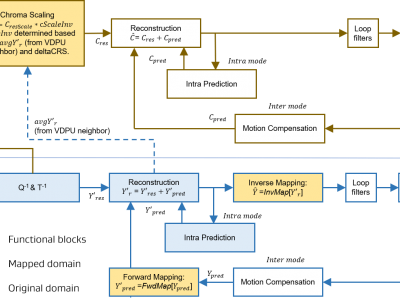Documents
Presentation Slides
Luma Mapping with Chroma Scaling in Versatile Video Coding

- Citation Author(s):
- Submitted by:
- FANGJUN PU
- Last updated:
- 23 March 2020 - 11:59pm
- Document Type:
- Presentation Slides
- Document Year:
- 2020
- Event:
- Presenters:
- Fangjun Pu
- Paper Code:
- DCC2020-ID189
- Categories:
- Log in to post comments
This paper describes a new video coding tool in the Versatile Video Coding standard (VVC) named as luma mapping with chroma scaling (LMCS). Experimental compression performance results for LMCS and non-normative examples for deriving LMCS parameter values are also provided. LMCS has two main components: 1) a process for mapping input luma code values to a new set of code values for use inside the coding loop; and 2) a luma-dependent process for scaling chroma residue values. The first process, luma mapping, aims at improving the coding efficiency for standard and high dynamic range video signals by making better use of the range of luma code values allowed at a specified bit depth. The second process, chroma scaling, manages relative compression efficiency for the luma and chroma components of the video signal. The luma mapping process of LMCS is applied at the pixel sample level, and is implemented using a piecewise linear model. The chroma scaling process is applied at the chroma block level, and is implemented using a scaling factor derived from reconstructed neighboring luma samples of the chroma block.

